
PROJECT ABSTRACT
The decline of honey bees is emblematic of a broader decline of wildlife around the world, and has an inextricable link to the current climate crisis. Through this project, our aim is for urban centres to serve as a sanctuary for pollinators and propagate biodiversity. Under the Farm Labour act of 1975, beekeeping was forbidden in all Spanish cities, an attempt by the then Francoist regime to “modernise” Spain, This law was recently repealed, as even in dense cities, honey bees can contribute to the support of healthy ecosystems and maintain agricultural productivity.
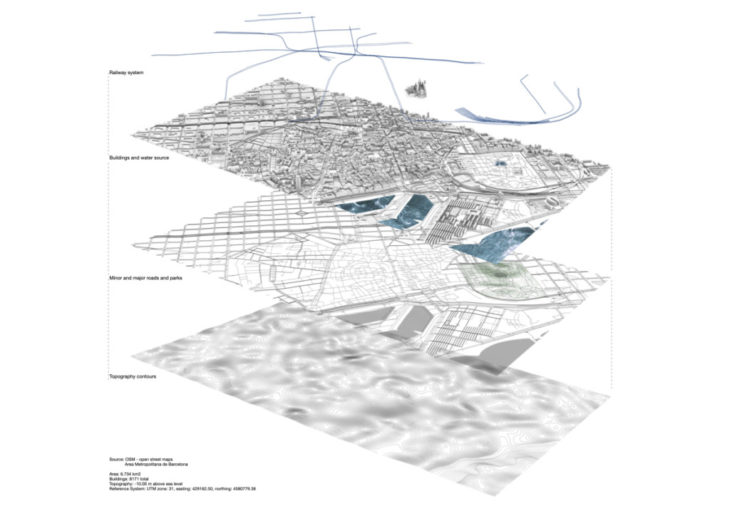
SITE
The site of this metabolic roof intervention is the Barcelona Cathedral – the heart of the Gothic Quarter. Surrounded by the neighbourhoods of El Raval, L’Eixample and El Born, it’s narrow streets and myriad historic buildings contribute to its compressed characteristic, dense from its founding. The limits of geography have hemmed the gothic quarter in and ensured that its residents are crammed tightly together with no access to green spaces in the immediate vicinity.
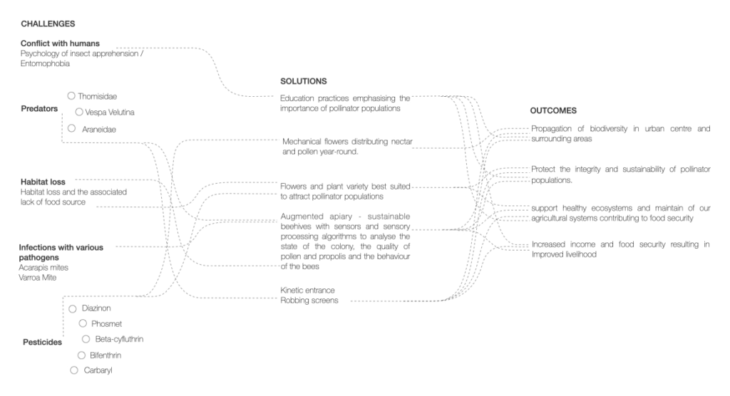
With this scope in mind, the project aims to reintroduce green spaces, to propagate biodiversity and support healthy ecosystems in urban centres. Pollination being the primary vector to achieve this while simultaneously addressing the decline of one of the most effective species of pollinators – honey bees.
RESEARCH
There is an ever-increasing demand for food security in the face of challenges such as climate change, land-use changes, habitat transformation, and the expanding human population. Proper pollination can improve the quantity and quality of fruits, nuts, oils, and other crops produced. Around the world, 5–8% of crop production would be lost without animal pollination, and pollination also provides many services to ecosystems, such as enhancing biodiversity and increasing food production without threatening the environment.
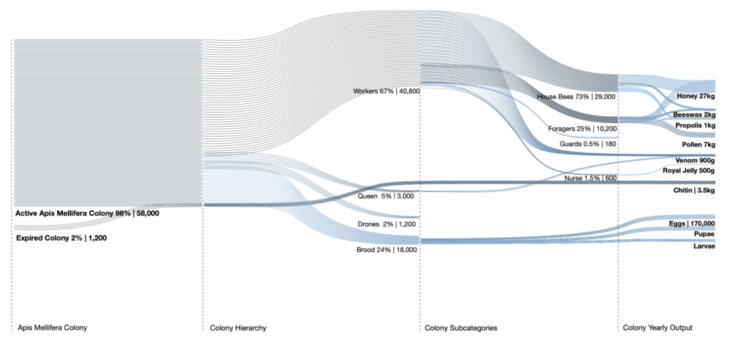
Sankey – Apis melifera Colony Hierchy and Outputs
Honey bees are the main pollinators of plants and are part of insect pollination which represent 9.5% of the total economic value of agricultural production used directly for human food within the EU. Honey bees are responsible for pollinating over 100 commercial crops. Both honey bees and wild bees are also economically important for sunflower seed production. Western honey bee have been widely used as pollinators since the application of pollination services began, and are the primary managed species worldwide for both honey production and crop pollination. Indeed, the Western honey bee ranks as the single most popular species of pollinator for crops globally, and is the most effective crop visitor worldwide, contributing approximately 13% of floral visits to 5% of plant species across all plant network,
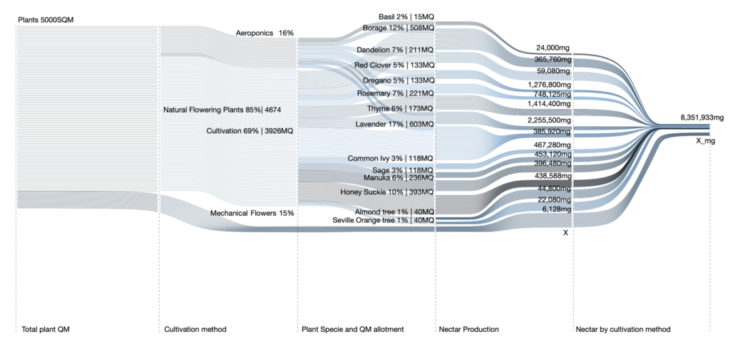
Sankey – Plant Species and Nectar Production
Plants play a key role in our ecosystem, namely by attracting pollinators. With pollinator species in dramatic decline due to habitat loss, forage scarcity, pesticide exposure, and other negative impacts, the necessity for creating pollinator gardens to provide much-needed nectar forage, is an ostensible one. Well-equipped pollinator gardens should be designed with bee nesting habitat into consideration as well. With this in mind the plant selection for this project identified the best bee plants for fulfilling both of these important needs.
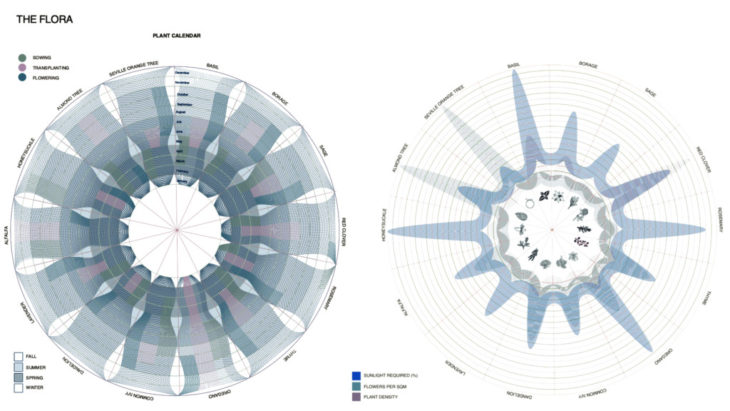
Calendar of Plant Cycle and Plant Requirements
The physical characteristics of particular plants preferred for forage –
- Flowers with big “landing pads” – particularly for Bumble bees, who require a sturdy landing pad before they can settle on a flower.
- Plants with many small flowers – Any plant with clusters of tiny flowers, such as goldenrod, oregano, and angelica
- Plants with hollow stems: particularly for solitary bees which build brood chambers either in small holes in the ground or in hollow plant stems.
- And plants that bloom when forage is scarce – Also among the plants will be included those that can provide pollen and nectar either very early or very late in the growing season, at a time when these resources are typically more scarce.
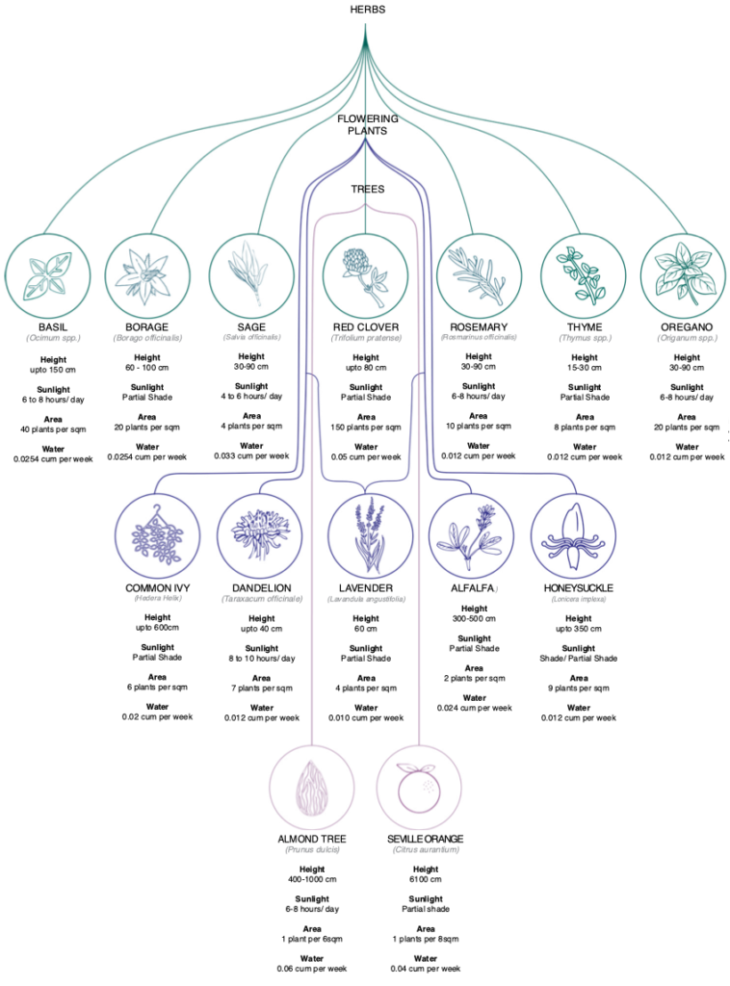
CONCEPT
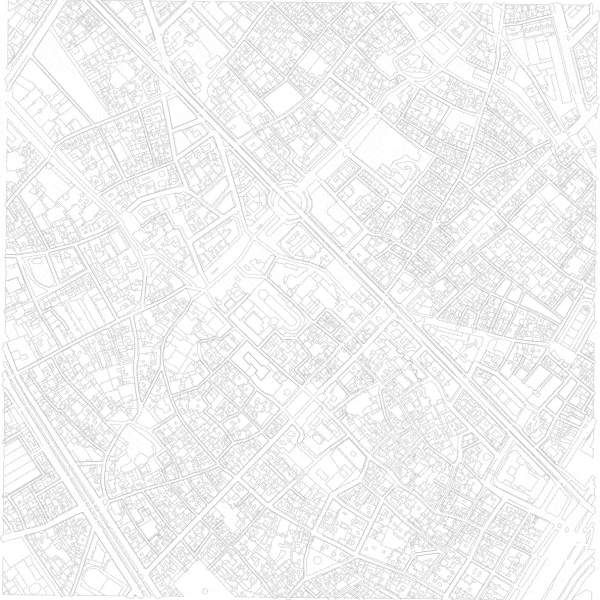
METABOLIC SYSTEM
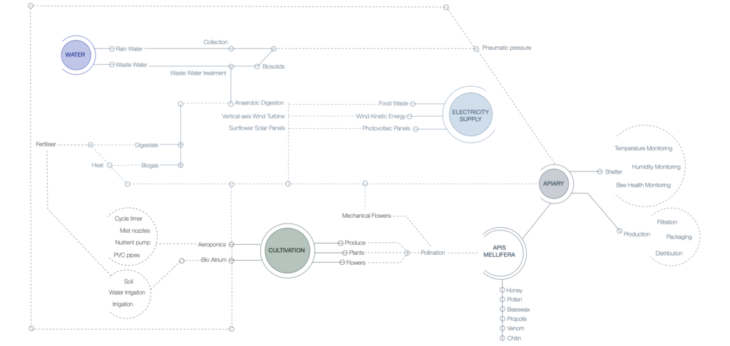 Metabolic Diagram
Metabolic Diagram
 Energy and Water Overview
Energy and Water Overview
ROOF MEMBRANE
The roof “Membrain” is a growing system which explores adaptable strategies within the context of gothic cathedrals. Centered on a new method of responsive roofs, the roof emphasizes the precision of adaptability in response to climate, the hacking of existing systems and the flux and dynamism of city pollinators.

The metabolic roof is embedded with intelligence, being able to scan the environment and adjust accordingly, providing an eternal spring with optimal growth environment dependent on the genus of flowering plants. It is also equipped with augmented apiaries.
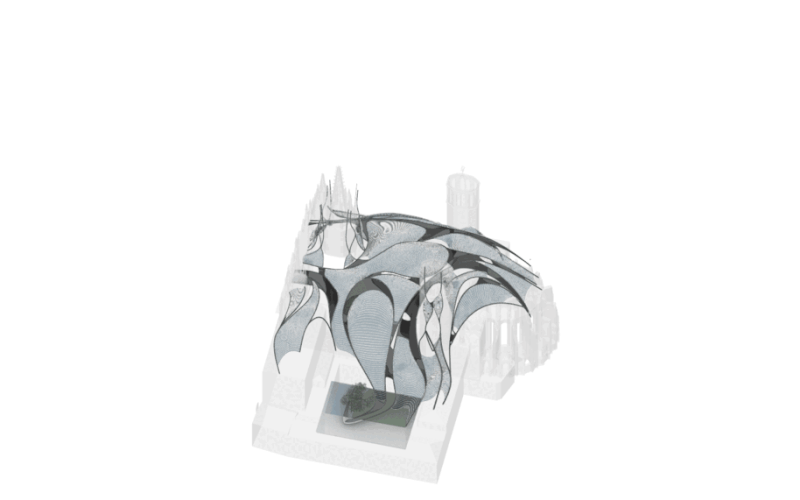
This aim for artificially created environmental conditions has for main function of providing forage for the inhabitants of the onsite apiaries, but also surrounding pollinators.
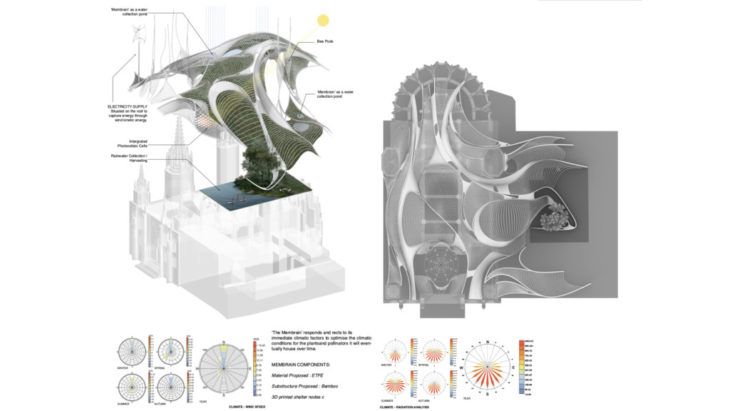 Ladybug Environmental Analysis Diagrams and Site Plan
Ladybug Environmental Analysis Diagrams and Site Plan
The roof engulfs the cathedral according to a system of elasticity that can accommodate site parameters including:
- Areas for maximum sun exposure
- Maximum growth area
- South facing entrance for the apiaries
- Pollinator nesting areas
- Water harvesting
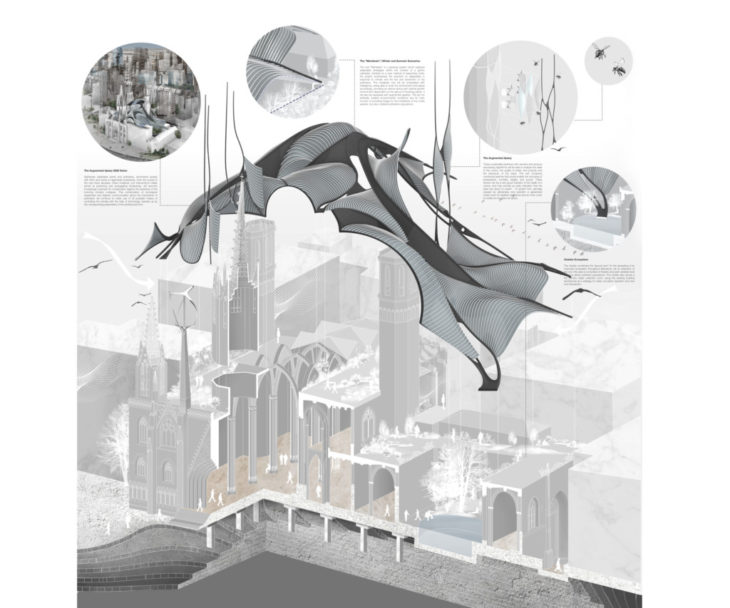 Project Hyperdrawing
Project Hyperdrawing
The aim of the project being to provide maximum forage for pollinators and an integrated experience for living in harmony with the natural world. Using over 50 species of flowers and plants, the buds and blooms of the vegetation form a composition for the roof structure. Vines and leafy foliage spring out between the cathedral roof and provide the perfect pollinator garden.
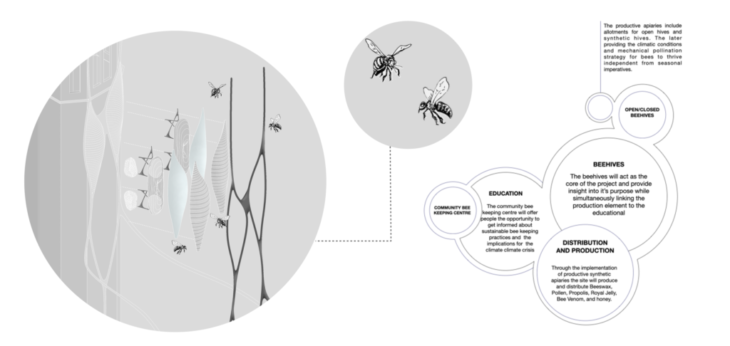 Beehives integrated into the octagonal clock towers
Beehives integrated into the octagonal clock towers
![]()
Pixel prototype
The pixel prototype is the result of a number of fast prototyping iterations, exploring techniques such as origami to create foldable and moving surfaces. The main purpose of the pixel is to use control points to move a surface instead of working directly on the surface itself. The prototype has 4 individually actuated control points, responsive to light and temperature. It was used for two comparative studies between different geometries embedded within the membrane surface. A comparison between the resulting geometries in identical control point positions, which informs about the flexibility and formal behaviour. And another study to compare the amount of transmitted light through the membranes, informing about the shading the different geometries create.![]()
Pixel Prototype – exploded axonometric

Cathedral membrane model
The learnings from the pixel prototype were then applied to the main Cathedral prototype where three responsive (light and humidity) control points are located within the bell tower, the main spire and the secondary roof tower. The membrane is subdivided into multiple parts in between a flexible structure. It is this structure that is moved by the control points. The prototype allows us to compare the movement of the whole membrane when different scenarios, base on the sensor inputs, are triggered.
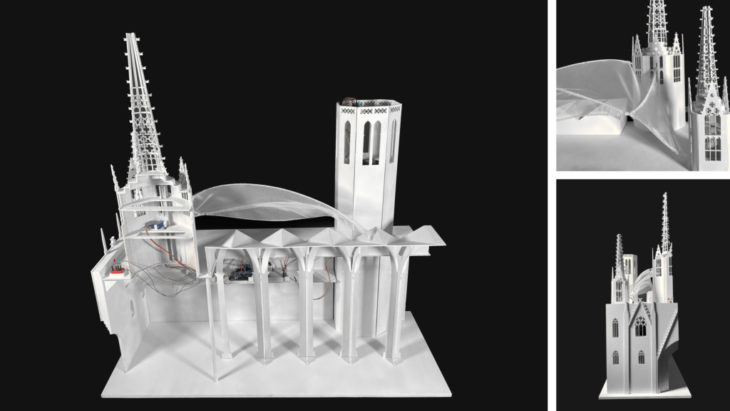 Physical model prototype
Physical model prototype
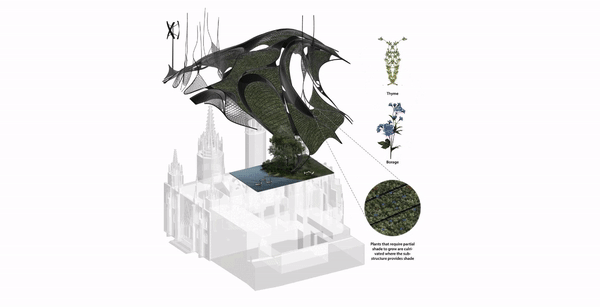
2050 VISION
Over the course of the next three decades, these metabolic roof interventions initially aimed at protecting and propagating biodiversity, will become increasingly important for conservation against the backdrop of the looming climatic collapse. This combination of ecological awareness and didactic communication about the importance of pollination will continue to make use of all possible means of controlling the climate with the help of technology, backed up by the corresponding parameters of the architectural form.
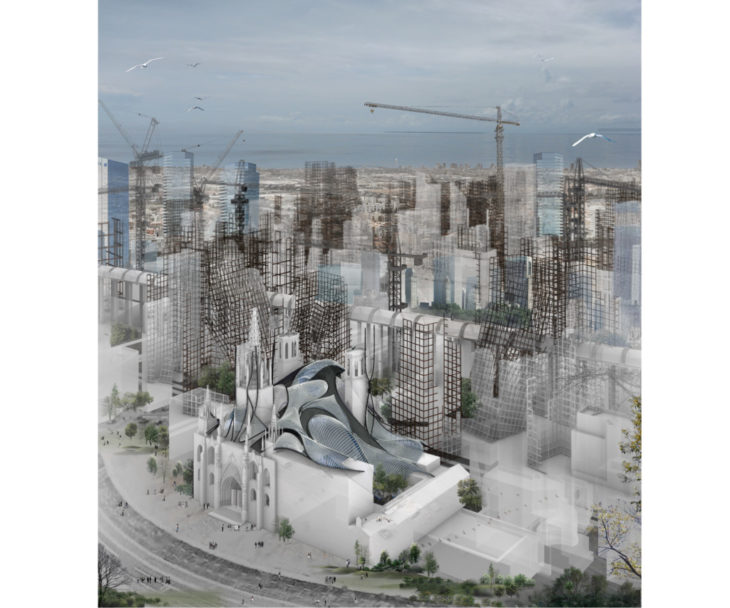
Apithe?sis is a project of IAAC, the Institute for Advanced Architecture of Catalonia developed during the Master in Advanced Architecture 2021/2022 by students: Solene Biche Cais, Disha Dineshchandra Shetty, Jett Demol Faculty: Javier Pena & Oriol Carrasco; Student Assistant: Alexander Dommershausen